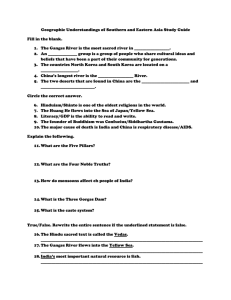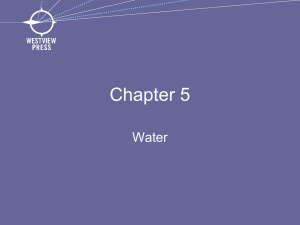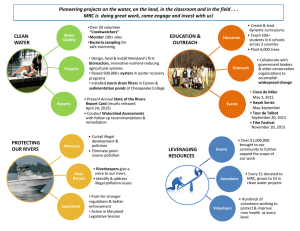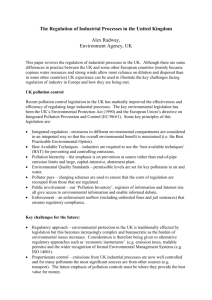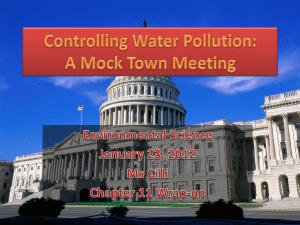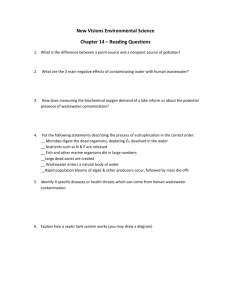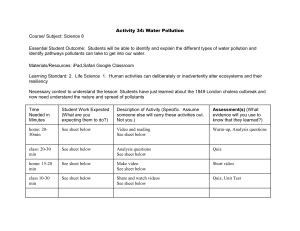interesting facts
advertisement
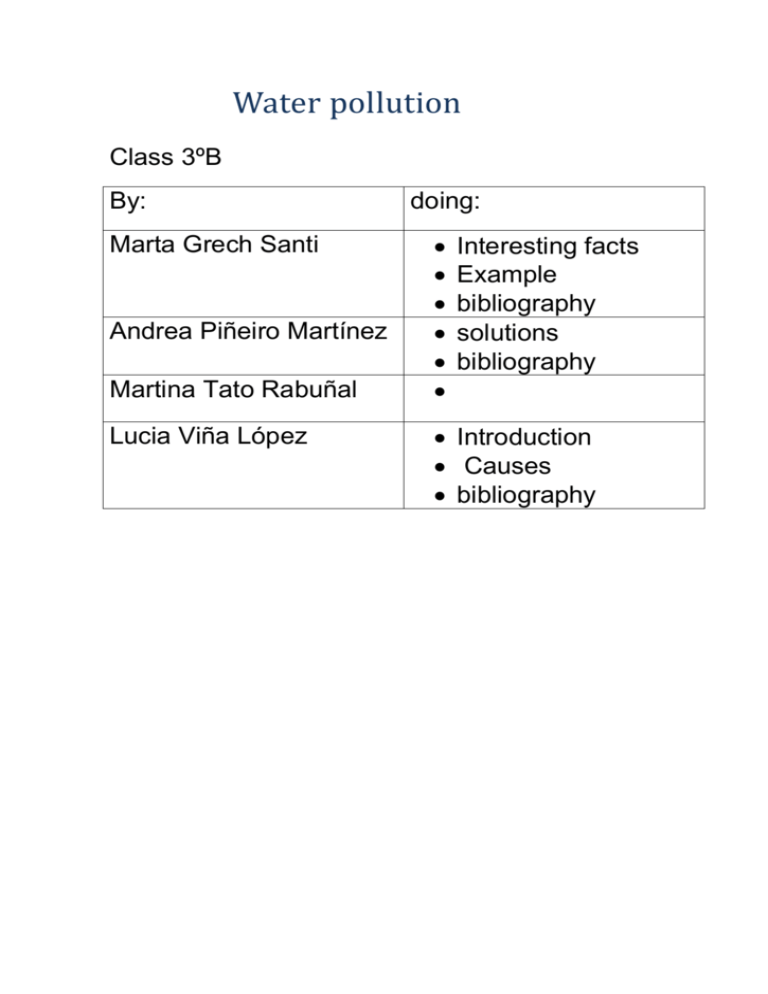
Water pollution Class 3ºB By: Marta Grech Santi Andrea Piñeiro Martínez Martina Tato Rabuñal Lucia Viña López doing: Interesting facts Example bibliography solutions bibliography Introduction Causes bibliography 1. INTRODUCTION Water resources are the different types of sources from where we obtain water. About three-fourth of the earth's surface is covered with water. But only a small portion of total water resources is actually available for human use. The 97.3% of the water in the world is salty, so just a 2.7% is fresh water, in which two thirds is frozen in glaciers. We use freshwater for drinking, washing, cleaning, cooking, and growing food as well as many other things. This is why water is so important, because it is basic for all living beings way of life. There are mainly three sources from where we can obtain water: Rain water: this is the primary source and the purest form of water. Surface water: Reservoirs Rivers Ponds, lakes... Ground water: Shallow wells Deep wells Springs Water pollution can come from a number of different sources. If the pollution comes from a single source, such as an oil spill, it is called point-source pollution. If the pollution comes from many sources, it is called nonpoint-source pollution. Most types of pollution affect the immediate area surrounding the source. Sometimes the pollution may affect the environment hundreds of miles away from the source, such as nuclear waste, this is called transboundary pollution. 2. CAUSES Sewage and wastewater Domestic households, industrial and agricultural practices produce wastewater that can cause pollution of many lakes and rivers. Sewage is the term used for wastewater that often contains urine and laundry waste. Untreated sewage water contaminates the environment and cause diseases Sewages waste is disposed into the sea. Marine dumping Dumping of litter in the sea can cause huge problems. Litter items such as 6-pack ring packaging can get caught in marine animals and may result in death. Different items take different lengths of time to degrade in water: Aluminium – Takes 200 years to degrade. Plastic packaging – Takes 400 years to degrade. Glass – It takes so long to degrade that we don’t know the exact time. Industrial water and water pollution Many industrial facilities use freshwater to carry away waste from the plant and into rivers, lakes and oceans. Pollutants from industrial sources include: o Asbestos, Lead and mercury have many harmful effects; they produce diseases such as cancer. o Oils Nuclear waste Nuclear waste is produced from industrial, medical and scientific processes that use radioactive material. Oil pollution Oceans are polluted by oil from oil spills, routine shipping, run-offs and dumping. An oil spill from a tanker is a severe problem because there is such a huge quantity of oil being spilt into one place. Oil cannot dissolve in water and forms a thick sludge in the water. This suffocates fish, gets caught in the feathers of marine birds stopping them from flying and blocks light from photosynthetic aquatic plants. Underground storage leakages Atmospheric Atmospheric deposition is the pollution of water caused by air pollution. In the atmosphere, water particles mix with carbon dioxide sulphur dioxide and nitrogen oxides, this forms a weak acid. Air pollution means that water vapour absorbs more of these gases and becomes even more acidic. When it rains the water is polluted with these gases, this is called acid rain. When acid rain pollutes marine habitats such as rivers and lakes, aquatic life is harmed. Global warming An increase in water temperature can result in the death of many aquatic organisms and disrupt many marine habitats. This rise is caused by global warming. Global warming is a process where the average global temperature increases due to the greenhouse effect. The burning of fossil fuel releases greenhouse gasses, such as carbon dioxide, into the atmosphere. This causes heat from the sun to get ‘trapped’ in the Earth’s atmosphere and consequently the global temperature rises. 3. INTERESTING FACTS Water pollution is a problem that affects almost all nation of the world. If proper stapes are not taken to control this means, it would lead to disastrous consequences near the future. Here you have some fact about water and water pollution to take coincidence About humans: we need drinking water, unpolluted water. -The humansbody is made up,a 50% o 65% water, but the human body of childrens is made up os 75% the same percent than the water that three is in the brain. -Humanscan survive a couple of weeks without food, but he only can survive few days About the world: -The total volume of water available on Earth is about 1.4 billion km and about 70% of the earth is covered in water. - The largest quantities of water are in the oceans. -Fresh water in the world is only 2.5% of the total water available on this planet. About cities: -220 million people that live in citys from developed countries doesn't have a water resource clase to their homes -90% from the waste water procedents the city from developed countries are vertidas without tratamiento into de rivers, lakes, and other cursos de agua negar de coast About children: -According to UNICEF, more than 3000 children die everyday due to consumption of contaminated drinking water. - About 700 million people worldwide drink contaminated water Water pollution Did you know? Fact1: A single quart of motor oil that seeps into the groundwater can pollute 250,000 gallons of drinking water. Fact2: According to a report by the Worldwatch Institute on nuclear waste, Lake Karachay in Russia is regarded as the most polluted spot on earth due to decades of dumping of nuclear waste. Spending an hour there can probably kill a person Fact3: The Ganges river in India is one the most polluted in the world. It contain sewage, trash, food, and animal remains. Each year 1.2 trillion gallons of untreated sewage, storm water, and industrial waste are dumped into U.S. waters. 4. SOLUTIONS PREVENTING WHAT CAN YOU DO? If we want to help the environment keeping the water clean, there are some simple guidelines in our everyday life: · Conserve water by turning water is not necessary. · Be careful about what you throw down your sink or toilet. · Use environmentally household products. · Take great care not to oversuse pesticides and fertilizers. This will prevent runoffs of the material into nearby water resources. · Do not throw litter into rivers, lakes or oceans TREATING INDUSTRIAL WATER AND WATER POLLUTION Industry is a huge source of water pollution, it produces pollutants that are extremely harmful to people and he environment: · Pollutants from industrial sources include: Lead, Mercury, Nitrates, Phosphates, Sulphur, Oils, and Petrochemicals. OZONE WASTEWATER TREATMEN Ozone wastewater treatment is a method that is increasing in popularity. An ozone generator is used to break down pollutants in the water source. · The generators convert oxygen into ozone by using ultraviolet radiation or by an electric discharge field. · Ozone is a very reactive gas that can oxidize pollutants found in water. SOLUTIONS We mustn´t pollute the water, because life without water there is no life, and the problem is increasing. STEPS FOR PREVENTION · Save water: this is the most important, and here are some examples, like don´t use the washing machine when the load is not high, use a mop or cloth to wash the yard instead of a hose pipe. · Watch what you are throwing: never throw oil, paints, litter, food... into the sink or toilet. · Use natural products: instead of chemicals that contaminate and pollute the water. 5. EXAMPLE River Ganges What is the river Ganges? The Ganges River, also called Ganga in honour of the goodness, is a holy river located in north India that flows toward the border with Bangladesh. It is the longest river in India and flows for around 2,525 km from the Himalayan Mountains to the Bay of Bengal. This river has the second greatest water discharge in the world and its basin is the most heavily populated in the world with over 400 million people living in the basin. What is the importance of the river Ganges? In India this river has many uses. It is a sign of religion used for ceremonies, it’s also used by people for drinking, bathing, cooking... it has a great importance due to its role in India, as it carries around 60% of the available fresh water, millions of people depend on it in order to survive. What causes river Ganges pollution? The Ganges is a much polluted river mainly because everyone releases their waste into. This river is also contaminated by human and animal excrements, some heavy metals and bacteria. Washing cloth and animals in the river, the diposal of waste from textiles, dying and brass making industries, and solid wastes like plastic bagsand flower garlands in the river thrown out by the towns men in the river main cause of its pollution. The Ganges River Pollution is now at such a high level that the amount of toxins, chemicals and other dangerous bacteria found in the river are almost 3000 times over the limit suggested by the WHO as 'safe'. Approximately 1 billion litres of raw, untreated sewage are dumped in the river on a daily basis. The rapid explosion of India’s population in the last 25 years and the changes in industries since the industrial revolution lead to an explosion in Ganges pollution. Thousands of human bodies are cremated on this river and many animal’s carcases are dumped in. The presence of coliform bacteria in the waters has increased well above. What are the consequecen of this pollution? The river is now a leading to an increase of infant and child mortality rates, skin problems and some more, serious disabilities What are the solucions to this problem? To reduce the threat of excessive water extraction, countries can irrigate crops more efficiently, use local knowledge, end perverse subsidies, cap water extraction levels, further community education and awareness, and support integrated river basin management. Achieve biodiversity conservation within the broader context of sustainable development and poverty reduction. 6. BIBLIOGRAPHY http://www.studymode.com/essays/Water-Resources-And-Their-Role-153863.html http://www.water-pollution.org.uk/links.html http://www.water-pollution.org.uk/treating.html http://www.water-pollution.org.uk/preventingyou.html http://www.water-pollution.org.uk/health.html http://www.water-pollution.org.uk/causes.html http://www.water-pollution.org.uk/types.html
